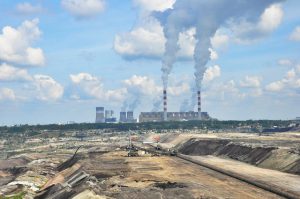Chinese company SEPCO I, a subsidiary of Power China, is helping Brazil’s Ouro Negro Energia finance a new coal-fired power plant in Pedras Altas, in the southern state of Santa Catarina. Critics say the project is not compatible with the country's commitment to limit climate change and may be more expensive than investing in renewables.
The power plant, which is located near Brazil’s main coal deposits and which is due to begin operating by the end of 2017, consists of two 300 megawatt (MW) units, and will require investment of approximately US$1 billion (6.7 billion yuan).
China’s role in financing the project means it is now involved in almost 1.3 gigawatts of new coal-fired power in Brazil, across three projects and locations. This is a small proportion of the approximately 79 projects (over 52 gigawatts) globally that Chinese banks and companies are financing or constructing. However, the coal projects in Brazil are the only ones in South America to involve Chinese companies, according to data from CEE Bankwatch Network.
The investments in new coal-fired power in Brazil are despite heavy investment by China in renewables in Latin America, and the trend of declining coal investment globally. In 2015, renewables surpassed coal to become the largest source of installed power capacity globally, according to the IEA’s Medium-term Renewable Market Report.
The Brazilian government initially included the plant in an auction of domestic infrastructure projects held in April 2016. But bidding was delayed after it decided to reevaluate the country’s energy strategy in light of the ongoing economic recession. Political and economic uncertainty in Brazil has raised questions about the viability of the coal project and wider concerns about the direction of the country’s climate and energy policies.
“There is not the slightest possibility that Ouro Negro will back out of the thermoelectric plant,” said company president Silvio Marques Dias Neto. He was responding to rumours that the project may not advance beyond the planning stage as a consequence of Brazil’s economic crisis. Chinese companies CITIC and Hebi Guochang Energy Development are also involved in the project although Dias has not ruled out the involvement of new partners.
Energy security
Brazil gets two-thirds of its electricity from hydropower but changing weather patterns and irregular rainfall means this energy source is becoming less reliable.
Widespread drought in the country has led to a shortfall in hydropower that has been covered by running back-up thermoelectric plants. But earlier this year consumers were stung with a 50% hike in electricity bills to cover the additional fuel costs.
According to Dias, Brazil should improve its energy security by constructing new coal-fired plants such as the one in Pedras Altas, and ensure greater diversity of energy sources. “Brazil should continue encouraging generation of renewable energy but this cannot be at the expense of baseload generation,” said Dias, who is a former president of the Rio Grande do Sul State Electricity Company (CEEE).
Proponents of new coal plants also argue that coal provides a reliable substitute for hydropower and an opportunity to further exploit significant reserves of coal at existing mines in Santa Catarina and Rio Grande do Sul.
Once operational, Ouro Negro would use coal from Candiota, the country’s largest coal mine, to produce power around the clock. The company says it will limit harmful greenhouse gases emissions through a desulphurisation system that utilises particulate matter abatement – technology that prevents minute solid particles from entering the atmosphere.
Bucking the renewables trend
Since signing the Paris Agreement last December, Latin American countries such as Mexico and Argentina have increased investment in renewable energy, which is increasingly viewed as a replacement for coal. In contrast, the carbon intensity of Brazil’s energy sector has increased in recent years despite the country signing up to the Paris Agreement and pledging to reduce carbon emissions.
Brazil is the 7th largest emitter of greenhouse gases in the world, with the energy sector accounting for 30% of national emissions, according to WWF-Brasil.
André Nahur, coordinator of the Climate Change and Energy Programme at WWF-Brasil, said that by continuing to invest in coal-fired power plants, Brazil is embarking on a path that makes little environmental, social or economic sense.
“If the government promotes a gradual reduction of economic incentives for thermoelectric plants in favour of solar power generation in Brazil, it could generate savings of over R$150 billion (US$460 million) for public coffers,” said Nahur, an expert on energy finance in Brazil.
Ouro Negro’s Dias said the company intends to invest in wind and small hydroelectric plants but maintained that Brazil is not taking advantage of its potential to generate affordable energy from coal. With the best technology, Dias claimed the impacts of burning fossil fuels could be limited. However, while so-called ‘clean coal’ technology does limit some greenhouse gas emissions, it does not reduce emissions of carbon dioxide.
Brazil’s interest in new coal also comes at a time of unprecedented pressure on coal investments globally, despite coal prices of around US$40-45 per tonne recently, compared with US$70-80 per tonne five years ago. China recently halted construction to 30 coal-fired power plants with a total capacity of 17 gigawatts. In April, Peabody Energy, the world’s largest coal company, filed for bankruptcy in response to the weakening global coal market. Companies, including France’s Engie, have abandoned investments in new coal, relegating it further down the list of energy generation options.
Thiago Almeida, climate and energy coordinator at Greenpeace, said that as well as being the state with the largest coal deposits in Brazil, Rio Grande do Sul has great potential for wind and solar energy. Constructing new coal plants there or in neighbouring Santa Catarina is “unnecessary and irresponsible”, he said.
“Building a solar or wind farm takes between six months to a year and a half. It’s worth bearing in mind that wind power is the second cheapest [form of energy] in Brazil and its price continues to fall,” Almeida added.
Over the next five years, the IEA expects costs to drop by 25% and 15% for solar PV and onshore wind respectively.
The original version of this story was published on Diálogo Chino.





